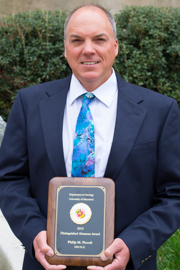
Philip Piccoli (Ph.D. 1992)
We are pleased to announce that Dr. Philip M. Piccoli (Ph.D., 1992) is the 2015 Distinguished Alumnus for the Department of Geology. Phil was a graduate student in the early years of the graduate program, and is well known to many of the students, faculty and staff who have been associated with the department down through the years. After a brief stint as a post-doc, Phil was appointed as a Research Scientist in our Department, and he is currently a Senior Research Scientist in the Department of Geology at the University of Maryland.
Phil arrived in College Park to begin his doctoral studies with Philip Candela after being awarded an M.S. in Geology from the University of Pittsburgh and B.A. degrees from the University of Montana in both Biology and Geology. Phil's Ph.D. dissertation was on apatite in igneous rocks of Eastern California, and his work set the standard for the use of apatite in the estimation of halogen fugacities and related parameters in silicic magmatic systems. He remains an internationally recognized expert in the field today. As a Research Scientist, Phil has advised or co-advised 15 graduate students, as well as nearly 45 undergraduate senior thesis students. Numerous other students and researchers have worked under Phil's guidance through his affiliation with the Maryland Nanocenter and the Center for Microanalysis, a position he has held since he was a graduate student. During his time at Maryland, Phil has served as PI/Co-PI on over $4.5M in grants from organizations including the National Science Foundation, the US Department of Energy, ARMY-DARPA, the Hudson River Foundation, and the Power Plant Research Program of the Maryland DNR. He has also taught numerous courses at the University ranging from physical geology and petrology, to forensic science. In his time here at Maryland, Phil has authored or coauthored 70 papers or chapters in books on topics including granites and ore genesis, synthesis of chemical compounds, and migratory behavior of fish in the Chesapeake Bay. (Phillip Candela, Department of Geology, 2015)
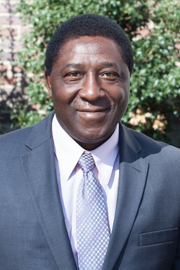
Eliot Atekwana (M.S. 1984)
We are pleased to announce that Dr. Eliot Atekwana is this year's Distinguished Alum for the Department of Geology. Eliot graduated with a BS in Geology from the University of Maryland in 1984. He obtained a Master's in Geology from Howard University in 1987 and a PhD in Hydrogeology in 1996 from Western Michigan University. Dr. Atekwana is a Professor of Geology at the Boone Pickens School of Geology at Oklahoma State University (OSU) where he has worked since 2006. From 2012 to 2013, he served as the Interim Head of the department. While at Maryland, Dr. Atekwana completed a senior thesis: Leachate retention properties of the saprolite beneath the Oaks Landfill near Laytonsville, Maryland under the supervision of Dr. Roger Nielsen. A list of Dr. Atekwana's publications can be viewed here. (Phillip Candela, Department of Geology, 2014)
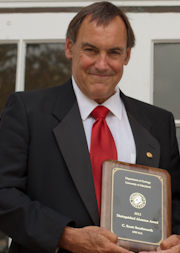
C. Scott Southworth (M.S. 1993)
Scott is a GS 15 research scientist at USGS, Reston, is a project chief, and has made significant contributions to our understanding of early Appalachian geologic history. He has published numerous research papers and maps on the subject. Additionally, he has published excellent "laymen" outreach type maps, as well as research papers on several of our eastern National Parks, including Great Smoky Mountains and Shenandoah NP and the Geology of the C&O canal. Geological mapping is arguably THE fundamental, and quintessential geological activity, and clearly, Scott is one of the present day masters of this venerable geological skill. He is presently working on a new map of the Virginia section of the Blue Ridge Parkway and Mount Rogers Park in southwest Virginia. He has given many talks both for the public and technical audiences on Appalachian tectonics. He was recently made a GSA Fellow. (Phillip Candela, Department of Geology, 2012)
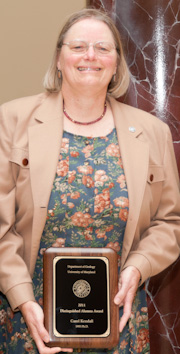
Carol Kendall (Ph.D. 1993)
Carol Kendall is a Research Hydrologist at the US Geological Survey in Menlo Park, California. Since 1990 she has been Chief of the Isotope Tracers Project, a National Research Program. The purpose of this project is to investigate and solve problems of national importance through the development of new methods and applications for CHNOS stable isotopes—and the best part, Carol gets to choose the problems. Carol's main field of interest is watershed biogeohydrochemistry, and her main research focus is tracing sources of nutrients and contaminants in large-scale aquatic ecosystems. Her other research interests include: the impact of isotopic fractionations and heterogeneity in shallow hydrologic systems on the determination of water and solute sources; nitrate sources and cycling; and, the use of biota isotopes as indicators of nutrient sources, land use and redox (reduction–oxidation) reactions. Carol received her B.S. and M.S. from the University of California, Riverside. After three years working as a geochemist at the California Institute of Technology, Carol moved east in 1980 to join the US Geological Survey in Reston, Virginia as a Research Hydrologist. While working full-time at the Geological Survey Carol completed a PhD at the University of Maryland in 1993 with Phil Candela as her adviser. In mid-PhD, she transferred back to the west coast to take up her present position at Menlo Park. Carol is co-editor of the 1998 book "Isotope Tracers in Catchment Hydrology"; she has taught dozens of isotope hydrology short-courses over the past 30 years for various federal, state, academic, and international organizations; she has served on 10 Doctoral committees; and, she has published about 150 papers and book chapters. During her time at the US Geological Survey, Carol has received 8 internal awards for superior and meritorious service; and in 2010 she was elected a Fellow of the American Geophysical Union for "outstanding contributions to isotope hydrology and biogeochemistry, and specifically for her pioneering work on the dual isotopes of nitrate." Please congratulate the Geology Distinguished Alumna for 2010—Carol Kendall. (Michael Brown, Chair, Department of Geology, 2011)
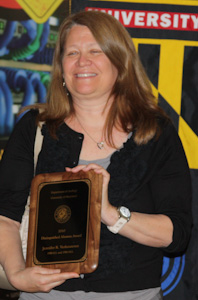
Jennifer Verkouteren (BS 1980, MS 1986)
It is my privilege to present to you Jennifer Verkouteren—the 2010 Geology Distinguished Alumna. Jenny received her B.S. in 1980 and her M.S. in 1986, both in Geology, and in both cases with Jerry Weidner as her research advisor. She is an internationally recognized expert in asbestos characterization as well as in trace explosives and narcotics detection. She has published research papers on a variety of topics that range from the mineralogy of asbestos to particle analysis, from the optical properties of minerals to the chemical analysis of explosives and narcotics, and from inkjet technology to the characterization of trace forensic residues. Jenny's Masters thesis concerned phase equilibria, which led to her first job at the National Institute of Standards and Technology (NIST) as an editor for the series "Phase Diagrams for Ceramists", a compilation of important phase equilibria that forms a critical foundation in fields from materials science to geology. Subsequently, she was asked lead a program mandated by Congress to establish procedures for optical analysis of asbestos. This work led to the development of standard reference materials for asbestos and the accreditation of hundreds of laboratories for the analysis of asbestos in schools, a research collaboration with Ann Wylie, and, in 1996, the Allen V. Astin Measurement Science Award. Among other tasks in the 1990s, Jenny was also involved in the certification of the size distribution of particles in hydraulic oil as a SRM, where she was instrumental in the development of new methods for particle counting using scanning electron microscopy, for which she received a NIST Technical Achievement Award. The events of 9/11 led to a redirection of priorities in the Surface and Microanalysis Science Division at NIST. Once again Jenny assumed a leadership role, this time heading up a multi-million dollar research effort, funded by the Department of Homeland Security, to build a metrology and standards infrastructure at NIST to support national priorities in trace explosive detection. In this work, Jenny has been instrumental in the application of new microscopy techniques for the characterization of explosives particles and the development of innovative methods for sampling trace particles from surfaces, such as those associated with fingerprint residues. More recently, she has begun leading a new effort related to forensic analysis and the development of cutting-edge measurement technologies for quantitative analysis of trace levels of illicit narcotics. During this work she has been involved in developing the novel use of precision inkjet technology to prepare chemical standards for trace analysis of explosives and narcotics. Please congratulate the Geology Distinguished Alumna for 2010—Jennifer Verkouteren. (Michael Brown, Chair, Department of Geology, 2010)

Bill Smith (BS 1981)
It is my privilege to present to you Bill Smith, who is the 2009 Geology Distinguished Alumnus. This is the 9th year of this award, and Bill represents the 4th Distinguished Alumnus whose career has been as a professional geologist in industry, complementing three who work as scientists for the Federal Government and two from the professoriate. This range illustrates the broad reach and utility of an education in Geology. Bill graduated from the University of Maryland with a B.S. in Geology in 1981, having completed a Senior Thesis entitled "Morphologic Distinction of Formations Using Fourier Analysis", under the direction of Galt Siegrist, one of the founders of the department. He has also earned an M.B.A., with a concentration in Environmental Management, from Widener University in 1999. In talking with undergraduates this morning, Bill emphasized, as others have done before him, the importance of the Senior Thesis in training him for the work environment. Bill is the President and Principal Hydrogeologist of Environmental Alliance, Inc., an engineering and environmental consulting firm headquartered in Delaware that he started in 1992. His company works primarily for other industrial companies, utilities and law firms, supplying consulting services in the areas of environmental site assessment and remediation, permitting, air-quality services, and expert testimony/litigation support services. Prior to starting his own firm, Bill served as Chief Operating Officer and Senior Vice President of Technology for Groundwater Technology, a publicly-held consultancy company that grew from two persons in 1981—Bill was the second employee—to about 1900 employees and close to $200M turnover by the time he left a decade later. Early in his career he managed several technology groups concerned with research and development, remediation—particularly bioremediation, engineering design and regulatory compliance. These activities led to opportunities to make key presentations at national environmental conferences and to write papers on diverse topics from complex, large-scale pump-and-treat projects to integrated sequenced biodegradation projects utilizing aerobic and/or anaerobic degradation pathways. It is my pleasure to present the Geology Distinguished Alumnus Award for 2009 to Bill Smith. Congratulations, Bill! (Michael Brown, Chair, Department of Geology, 2009)
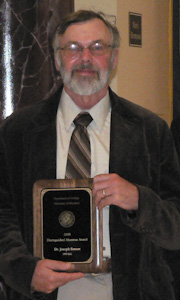
Joseph P. Smoot (BS 1973)
Celebrating the success of our alums reminds us of the varied careers that our graduates follow and of the serendipity involved in their success. This year it is my privilege to introduce to you Joseph P. Smoot as the Geology Distinguished Alumnus for 2008. Joe received his BS in 1973—essentially a geology degree complete with senior thesis, but in fact the last year of geology within the BS in agronomy program—and then switched to Johns Hopkins for his PhD, working on the sedimentology of an ancient saline closed basin in Wyoming. After his PhD in 1978, Joe became an Assistant Professor at SUNY Stony Brook before moving to the U.S. Geological Survey in 1983. Currently, he works with the Eastern Climate and Eastern Earth Surface Processes Teams based at Reston, VA. Joe has combined a background in the fluid mechanics of sediment transport and aqueous geochemistry with field mapping and fabric analysis of sedimentary rocks to unravel how ancient sedimentary sequences formed. This unique process-oriented approach has freed him from the constraints imposed by specific depositional processes, sediment types, environments or intervals of time. Among his accomplishments, Joe devised a sedimentological framework for the Newark Supergroup basins in the eastern US and he recognized a variety of depositional environments in the geological record that were previously unknown despite a hundred years of research. Joe is an internationally recognized expert in non-marine evaporites, Early Mesozoic rift basins and the sedimentary record of climate change in lakes. It is this last specialty— the sedimentary record of climate change in lakes—that is important. I'm sure Joe did not realize as a student in the 1970s exactly how important sedimentary basins were to become in relation to the record of climate change they preserve! Serendipity or astute planning aside, Joe has worked on the climate record preserved by lacustrine sediments in the western U.S. for a large part of his career, contributing significantly to our understanding of long-term climate change on Earth. As we have come to expect from our alums, Joe is a frequent invited speaker at international conferences and is tireless in running field excursions to pass on his experience. It is my pleasure to present the Geology Distinguished Alumnus Award for 2008 to Joe Smoot. Congratulations Joe! (Michael Brown, Chair, Department of Geology, 2008)
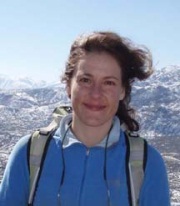
Carmala Garzioni (BS 1994)
It is a particular pleasure to present the Geology Distinguished Alumna for 2007—Carmala Garzioni. Carmy came to Maryland soon after I arrived here and received her BS in 1994. Currently, she is Associate Professor of Earth & Environmental Sciences at the University of Rochester. For her senior thesis research Carmy entered the world of isotope geochemistry, funded with a summer inern grant from Undergraduate Studies, choosing to work with Rich Walker on ". . . the origins of a lithium-rich pegmatite, North Carolina." This foundation, and her inference that "Rich Walker has such a great life" enabled Carmy to move to the University of Arizona, where she completed her graduate degrees. Her research concerned the provenance of sedimentary rocks using Nd isotope geochemistry (MS) and studies of the tectonic and paleo-elevation history part of the Tibetan Plateau (PhD). She was hired at Rochester in the third year of her PhD studies. Carmy's present research interests concern the tectonic and climatic evolution of sedimentary basins and related mountain belts—essentially combining themes from her graduate training. This is 'big picture' research (funded in part by the Continental Dynamics program at the NSF). The development of large mountain belts is believed to have a significant impact on global climate and geochemical budgets, and sedimentary basins develop through a complex interplay of tectonics and climate that is recorded by the infilling sediments. What Carmy does is to decode and invert the information recorded in the sediments to unravel the complexities of mountain building, to obtain paleoelevation, to understand unroofing of deeper crust, and to characterize paleoclimate, all of which have implications for global climate, climate change and geochemical budgets. Carmy's research is interdisciplinary, crossing traditional boundaries, and highly collaborative—it is an Earth systems approach! She describes her research life as ". . . exhilarating" and is grateful to be in an academic environment, which allows her the freedom to pursue interesting problems. It's a tough life working at the top of the world with fieldwork in Tibet and the Bolivian Andes, but someone has to do it! Carmy also received the 2007 U. of Arizona Geosciences Alumni Achievement Award and she has been recognized as an outstanding speaker and educator. It is my pleasure to present the Geology 2007 Distinguished Alumna Award to Carmala Garzione. Congratulations Carmy! (Michael Brown, Chair, Department of Geology, 2007)
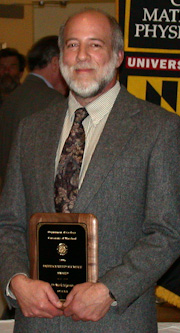
Mark Feigenson (BS with Honors 1974)
This year the Geology Distinguished Alumnus is Mark Feigenson, who received a BS with Honors in 1974 and is now Professor of Geological Sciences at Rutgers University. Originally a Physics major, Mark switched to Geology after taking an introductory course from Galt Siegrist, the Department's first Chair. Mark's senior thesis concerned the Woodstock quartz monzonite, with Jerry Weidner as advisor. While at George Washington working with John Lewis on volcanoes in the Dominican Republic, Mark began collaborating with scientists from the Department of Terrestrial Magnetism, where he was introduced to isotope geochemistry as part of his Master's research. After completing his M.S., Mark received a Phelps-Dodge award to study at Princeton for his PhD, where he split time working on magma physics with Frank Spera and mantle geochemistry back at DTM with Al Hofmann. Mark's dissertation research on the geochemistry of Hawaiian lavas demonstrated that the degree of mantle melting decreases sharply as a volcano moves with the Pacific plate off the deeper mantle plume source. This work was one of the stimuli that led to the Hawaii Scientific Drilling Project, with which Mark is still affiliated. With Al Hofmann, Mark extended the procedure known as geochemical inverse modeling, and used the technique to constrain geophysical models of melt production; this work resulted in a series of 3 well-known landmark papers. In 1982, Mark started teaching at Rutgers University, and began a collaboration with Mike Carr, working on Central American volcanology. Over the years, they have studied volcanoes from Guatemala to Panama, and have shown how the changing dip of the subducted plate controls chemical variations in the lavas along the arc. Most recently, Mark has used lead isotopes to show that the volcanoes of central Costa Rica are distinct from the rest of the arc, and are tapping remnants of the Galapagos mantle plume. This result implies that the Caribbean Plate originated in the Pacific Ocean, over the Galapagos plume, and has been transported eastwards to its current location in the Atlantic Ocean over the past 100 million years. It is my pleasure to present the Geology 2006 Distinguished Alumnus Award to Mark Feigenson. Congratulations Mark! (Michael Brown, Chair, Department of Geology, 2006)
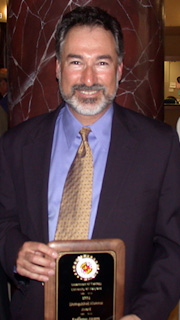
Guillermo (Willy) Accame (BS 1980)
Today it is my privilege to present to you Guillermo (Willy) Accame—the 2005 Geology Distinguished Alumnus. Willy graduated from the University with a B.S. in 1980. His senior thesis advisor was Ann Wylie, and his research involved a "Preliminary evaluation of Maryland groundwater for asbestos". While at Maryland, Willy co-founded the Student Chapter of the American Institute of Professional Geologists and the Undergraduate Geology Club, and he served as the undergraduate representative to the Search Committee that selected Luke Chang my distinguished predecessor as Chair. After graduation, Willy was granted a research fellowship at Purdue University, where he completed a double Masters in Geochemistry and Remote Sensing in 1983. While at Purdue, Willy participated in a joint project with the JPL for the design of one of the first geographic information systems to be developed (GIS), integrating rectified digital satellite imagery to create a base map for Bolivia; he also conducted research into the origin of the California diamond deposits, which are secondary alluvial (river) deposits, using sediment chemistry and remote sensing to reconstruct the source of the paleo-channels in the Sierra Nevada. Willy's MS thesis was "Mineralogical, trace-element, and LANDSAT multispectral evaluation of gossans in the Alma Mining District, Colorado." Willy has subsequently followed a most fascinating career. After graduating from Purdue, he continued working in diamond exploration throughout the US, and he was on the team that contributed to the discovery of the Wyoming-Colorado State-Line diamond deposits. However, in the mid-1980s Willy turned his attention to the development of a technique using color-infrared aerial photography and GIS technology for the mapping of wetlands. He applied this technology to the inventory and mapping of all non-tidal wetlands in NJ. In 1992, Willy joined Environmental Strategies Consulting and focused on the investigation and remediation of contaminated industrial properties. He negotiated the first mixed-funding Superfund Removal Action in NJ, involving the excavation and disposal of over 6,000 buried drums, and negotiated the first Resource Conservation and Recovery Act Voluntary Corrective Action at an industrial facility in the NJ-NY region. In 1999, Willy established a Denver office for Environmental Strategies Consulting and in Denver developed a web-based information management practice; in 2000 he participated in the technical legal defense team for the Summitville mine in Colorado, one of the biggest mine environmental legacies in the US. In 2003, Willy was elected to the Board of Directors of Quanta Indemnity Company, a specialty lines insurance company that provided the technical underwriting for Denver International Airport, and the parent company of Environmental Strategies Consulting, where Willy is a Partner and General Manager of the Denver office. Willy and I have one element in common, we both enjoy the outside and we have used our professional opportunities to see the world! In addition to the usual range of outside activities common to many Geology graduates, and I point this out especially for those of you who may want to twist Willy's arm, he is a Martial Arts expert—holding Black Belts in Tae Kwon Do and Kenpo, and trained in Ninjutsu, Kung Fu, Shorin-Ru and Tai Chi Chuan; he teaches at a martial arts school in Denver. Please congratulate the 2005 Geology Distinguished Alumnus Guillermo (Willy) Accame. (Michael Brown, Chair, Department of Geology, 2005)
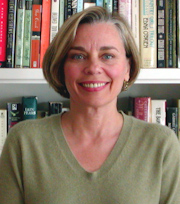
Robin Reichlin (BS 1976)
The College Academic Festival is one of the highlights of our year. This year it is important to remind ourselves that we create success through excellence despite a climate of declining fiscal support from the State. Today it is my privilege to introduce Robin Reichlin – the 2004 Geology Distinguished Alumna. Robin graduated B.S. (Cum Laude) in Geology in 1976. In the face of ever increasing publicity about how good the incoming freshmen are each year, perhaps we should also remind ourselves how good they used to be! Robin's Senior Thesis Advisor and undergraduate research mentor was Ann Wylie, now Assistant President—success certainly breeds success! Robin moved on to graduate studies at SUNY Stony Brook in Mineral Physics, where her work concerned the crystal chemistry of orthogermanates (proxies for the deep mantle minerals). After graduate school, she moved to the UC system on an IPA to the Lawrence Livermore National Laboratory where she built a high-pressure diamond anvil cell facility to do research in condensed matter physics and geophysics, studying the properties of materials under extreme pressures and temperatures. We are aware that Physicists move into Earth Science, but it's nice to see an Earth Scientist move into Physics and lead the way! From 1993 to 1995, Robin was Group Leader of the Experimental Geophysics Group, which involved technical and administrative management of 15 scientists and several technicians, as well as management of the Group's experimental facilities in several buildings on the campus. Management of science suited Robin and in 1995 she moved to the National Science Foundation, where she is now Senior Program Director for the Geophysics Program, managing a budget of $18M to support science in the fields of seismology, mineral physics, geomagnetism, rock mechanics, geodynamics, geodesy, potential fields, etc. Robin's approach at the NSF has been to foster and promote collaborative, interdisciplinary studies. She has accomplished this mainly through the establishment of new initiatives focused on bringing together scientists from disparate backgrounds to address grand challenges in Earth Science, with particular reference to understanding processes in the Earth's interior. Thus, she has been involved in developing and managing the Cooperative Studies of Earth's Deep Interior and Collaborations in Mathematical Geosciences programs, the Information Technology Research and Science and Technology Centers competitions, and initial development of the EarthScope MRE Initiative, which was funded by Congress in 2003 at the level of $355M. It is my pleasure to present to you the 2004 Geology Distinguished Alumna Robin Reichlin. Congratulations Robin! (Michael Brown, Chair, Department of Geology, 2004)

Michael Wietrzychowski (MS 1989)
In Geology, celebrating the success of our alumni reminds us of the varied careers that our graduates follow. This year the Geology Distinguished Alumnus is Michael Wietrzychowski. Mike was a graduate student in the 1980s, working with Prof. Galt Siegrist, who is now at the University of Guam. Mike's thesis, completed in 1989, was entitled "Depositional facies distribution and diagenetic variation within Pleistocene carbonate sequences on Rota, Mariana Islands", which is a small island just N of Guam. Currently, Mike is with Cureton, Caplan & Clark, a New Jersey Law Firm. He assists management clients with a variety of environmental, labor and employment issues. The environmental issues include liability and cost recovery litigation, environmental compliance, remedial oversight and commercial transactions. Thus, Mike has taken his training in Geology and applied it to a variety of interesting problems in environmental science and law, becoming one of the experts in this increasingly important sphere of activity. Before entering the practice of law, Mike worked for the international environmental consulting firm of Booz, Allen & Hamilton in Washington, D.C., where he provided policy and technical support to the Environmental Protection Agency, including developing the 1990 National Contingency Plan under Superfund. While working for Booz, Allen & Hamilton Mike saw the light, moved on to Law School and hasn't looked back since. We have enjoyed a wonderful 24 hours with Mike and his wife Maria, and I cannot over-state the value to our students and faculty of these interactions with successful alumni. It is my pleasure to present to you the 2003 Geology Distinguished Alumnus Mike Wietrzychowski. Congratulations Mike! (Michael Brown, Chair, Department of Geology, 2003)
Frederick (Rick) W. Zimmerman (BS 1975)
I have always enjoyed Commencement, for me it is the raison d'etre of an educational institution. However, celebrating the success of our alumni has also proven to be an equally worthwhile experience. This year it is a privilege to introduce to you Frederick. W. (Rick) Zimmerman as the Geology 2002 Distinguished Alumnus. We have enjoyed Rick's company in the Department over the past two days, and I cannot express adequately the value to our students and faculty of these interactions with successful alumni. We have had a ball! Rick has always marched to the beat of his own drum, and his career reflects this independent quality. He completed his degree in 1975, with Ann Wylie as his senior thesis advisor. I'd like to think that we helped prepare Rick for the successful career in Oil and Gas that followed, but he assures me that it was serendipity that led to a job offer in Texas after a period of travel and adventure. However it happened, it's clear that Rick's individuality and ability to see where the industry is moving have been as important as his training in Geology. Since graduating Rick has 25 years experience in exploration and development geology and in reservoir engineering. He has been responsible for or involved in the generation and drilling of hundreds of wells. Since 1986 he has been President & CEO of Texas Independent Exploration, a company with around 20 staff that concentrates on detailed, in-depth geological and engineering evaluations of oil and gas properties, I believe these days exclusively gas. His ability to locate small reserves (5 acres, zero to millions of dollars of gas) using 3-D computer-generated imagery with geological insight has made him a leader among the small independents. It is my pleasure to present Rick for this award, which I'm sure is particularly rewarding for him in the presence of his father and other family members. Congratulations Rick! (Michael Brown, Chair, Department of Geology, 2002)
Francis (Frank) H. Chapelle (BS 1976)
Francis H. (Frank) Chapelle is a research hydrologist in the Microbial Studies Section at the United States Geological Survey District Office in Columbia, SC. At UM he completed degrees in Music (BA '74) and Geology (BS '76), including a senior thesis in Geology entitled "An Investigation of Stylolites". Frank is one of the pioneers in 'BioGeoscience', evidenced by the 1993 (2 nd Ed 2001) publication of his ground breaking and now world-renowned book "Ground-Water Microbiology and Geochemistry." Few geologists were thinking about microbiology ten years ago, let alone writing a book on the subject. Frank's second book "The Hidden Sea: Ground Water, Springs, and Wells" was described by one reviewer as a " .. masterful integration of the mystical, cultural, and technical aspects of ground water hydrology." He is also an Associate Editor of the Journal 'Ground Water'. Last year Frank won the GSA Hydrology Division O.E. Meinzer Award for excellence in the field of geohydrology and geochemistry (Meinzer was a noted USGS scientist in these fields). Frank's award was for ".. significantly advancing our understanding of ground water microbiology and the role of microbes in influencing ground-water quality and sediment chemistry in subsurface systems." It is my pleasure to present the Department of Geology Distinguished Alumnus Award for 2001 to Francis H. Chapelle. Congratulations Frank! (Michael Brown, Chair, Department of Geology, 2001)
